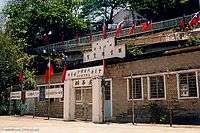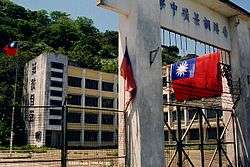Chinese Association for Relief and Ensuing Services
| 中華救助總會 | |
|
Rennie's Mill Middle School prior to its destruction in 1995 built and maintained largely through FCRA funding. | |
| Abbreviation | FCRA |
|---|---|
| Formation | 1949 |
| Founder |
Soong Mei-ling[1] Chen Cheng[1] Hu Shih[1] Ku Cheng-kang[1] Fang Chih[1] |
| Founded at | Taipei, Republic of China |
| Headquarters | 7F No 4 Chung Hsaio W Road, SEC 1, Taipei[2] |
Honorary Chairman | Ge Yuqin (葛雨琴)[3] |
Chairman of the Board | Zhang Zhengzhong (張正中)[3] |
| Website |
www |
Formerly called | Free China Relief Association (中國大陸災胞救濟總會) |
The Free China Relief Association (Chinese: 中國大陸災胞救濟總會) is a Non-Governmental Organization headquartered in Taipei, Republic of China (Taiwan). The organization specializes in forced migration, refugee assistance and disaster relief.[2]
History
The Free China Relief Association was founded in 1949 and incorporated on 4 April, year 39 (1950), as the "Chinese Mainland Relief Association" (中國大陸災胞救濟總會),[3][4] following the defeat and retreat of the Republic of China from the mainland. The Association was tasked with providing assistance to frontline troops, the many refugees fleeing the Mainland after the war, assisting the Nationalist insurgents operating within Mainland China and generally promoting the values of free China on behalf of the ROC.[5]
The articles of association listed 100 people as directors including Ju Zheng (居正), Soong Mei-ling (蔣宋美齡), Ku Cheng-kang (谷正綱), Fu Sinian (傅斯年), Fang Chih (方治), Chen Qitian (陳啓天), Wan Hongtu (萬鴻圖), and Zheng Yanfen (鄭彥棻). An additional 61 people were listed as supervisors including Yu Youren (于右任), Zou Lu (鄒魯), Chiang Monlin (蔣夢麟), Yu Jiaju (余家菊), Chhoà Pôe-hóe, Huang Chaoqin (黃朝琴) and Chen Weiping (陳維屏). The first meeting took place between 12 and 24 April, 1950.[6]
1950's

In 1950, with the CCP was strengthening its hold over the former Republic of China. The FCRA conducted hundreds of operations to airdrop 70,000 tons of rice from Taiwan and anti-Communist propaganda leaflets throughout Eastern China. These drops were called "Mainland Disaster Relief Drops From Taiwanese Compatriots" beginning a long history of operations involving supply airdrops by FCRA in Greater China and Southeast Asia.[7]
In May 1950, the FCRA raised USD 10 million with the goal of aiding refugees in British Hong Kong who had set up a camp at Rennie's Mill.[8][9]
In summer of 1952, the FCRA was informed that the Social Welfare Office of British Hong Kong intended to end food rationing at the Rennie's Mill camp the following year in an effort to disperse the camp's inhabitants. The move by British authorities created a vacuum of authority which was filled by the FCRA and the ROC government by extension, essentially creating an enclave of the Republic of China inside British Hong Kong that would last until around 1997.[4]
1960's
In May 1960, the FCRA hoarded around 100,000 tons of rice in an attempt to ship it to the Mainland. The offer was rejected by the PRC, after which the FCRA prepared around 10,000 ration kits, each weighing around 1 pound, to be airlifted and dropped or otherwise smuggled into the mainland. Chiang Kai-shek said the following of the PRC's attempt to ignore the Nationalist relief offer:[10]
...then my government will take every possible risk to deliver relief supplies to the mainland on our own initiative, by land, sea or air— Chiang Kai-shek, Lawrence Daily Journal World (31 January, 1961)
1970's
In 1976 following the 1976 Tangshan earthquake , the Free China Relief Association conducted an operation to send 170,000 balloons filled with relief aid and propaganda leaflets across the Strait to the Mainland in collaboration with the Ministry of National Defense. The move was made following an official rejection of aid shipments from the ROC by the PRC.[7]
1980's
In 1988, the FCRA sent the PRC $100,000 USD to help Chinese flood victims. This marked the first successful instance of direct humanitarian assistance to the PRC from an ROC institution.[7]
1990's

In 1991, the association changed its name to the China Relief Association (中國災胞救助總會).[3]
In July 1992, the FCRA donated $300,000 USD to the Chinese Red Cross after a series of floods and droughts had affected six Mainland Chinese provinces.[7]
In December 1993, the association donated NT $1,371,767 to benefit the victims of a tsunami that struck South Asia.[3]
2000's
In 2000, the association re-branded itself as the Chinese Association for Relief and Ensuing Services or "CARES" (中華救助總會) after significant downsizing and a transition away from international relief work, transforming itself effectively into an internal social welfare organisation with some international work still ongoing.[3]
Present Day
The organisation's mission currently includes assisting the integration of Mainland spouses into Taiwanese society, providing services to disadvantaged, elderly and aboriginal groups on Taiwan, providing emergency relief to the same groups including care and assisted living services, participation in international humanitarian work, providing assistance to former refugees and their descendents in Thailand and Burma and Organising a regularly held Social Welfare Forum to improve existing welfare services.[3]
Publications
- Employment Services and Vocational Assistance of Chinese Refugees in Taiwan. Taipei: Free China Relief Association. 1956.
- FCRA Relief Work in Kinmen & Matsu. Taipei: Free China Relief Association. 1956.
- The Voice of Refugees from the Chinese Mainland. Taipei: Free China Relief Association. 1958.
- Resettlement of War Disabled Refugees. A Significant Project Completed by FCRA in Cooperation with FERP-U.S.E.P. (Illustrated ed.). Taipei: Free China Relief Association. 1958.
- The Mass Exodus of May 1962. Taipei: Free China Relief Association. 1962.
- FCRA Relief Work in Hongkong and Macao. Taipei: Free China Relief Association. 1965.
External sites
References
- 1 2 3 4 5 China Handbook 1956-57. Taipei: China Publishing Company. 1956. p. 221 – via Cornell University.
- 1 2 "Free China Relief Association (FCRA)". forcedmigration.org. Forced Migration Online. 2015. Retrieved 5 April 2016.
- 1 2 3 4 5 6 7 中華救助總會簡介. cares.org.tw. CARES. 2007. Retrieved 31 May 2016.
- 1 2 Lan, Kenneth On-wai (2006). "Rennie's Mill: The Origin and Evolution of a Special Enclave in Hong Kong" (PDF). hub.hku.hk. The University of Hong Kong. Retrieved 12 April 2016.
- ↑ "11 Red Junks And Gunboats Sunk in Raids". Oshkosh Daily Northwestern. Taipeh. September 28, 1954. p. 2. Retrieved 11 November 2015.
TAIPEH, Formosa U.P.)--Chinese Nationalist P47 Thunderbolts flying through heavy typhoon weather sank 11 Communist junks and gunboats and damaged scores more today in raids off the coast of Fukien Province near Amoy Island. Nationalist air force headquarters said the Reds apparently were massing their junk fleets under the cover of the typhoon. The Nationalist navy began a stepped-up patrol action off the coast in an attempt to discover other concentrations of Communist vessels. A Nationalist relief official said the Communist Shelling of Quemoy Island has caused the death of 27 Civilians and rendered 1,465 Civilians homeless. Fang Chih, Secretary
- ↑ 救災總隊. pccu.edu.tw. Chinese Culture University. 2016. Archived from the original on 25 April 2016. Retrieved 13 April 2016.
- 1 2 3 4 Thompson, Drew (10 September 2009). "The Geopolitics of Cross-Strait Disaster Relief". jamestown.org. Jamestown. Retrieved 6 April 2016.
- ↑ Tatlow, Didi Kirsten (29 July 1996). "Hong Kong's "Little Taiwan" - and Flags - Passing Into History". news.google.com. The Day. Retrieved 8 January 2016.
- ↑ FCRA Relief Work in Hongkong and Macao. Free China Relief Association. 1965. p. 46 – via University of Michigan.
- ↑ "China Expected to Reject Offer of Food by Nats". Lawrence Daily Journal World. Lawrence. 31 January 1961. Retrieved 11 April 2016 – via Google News.
